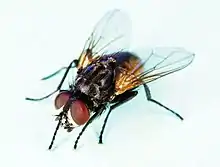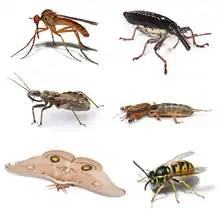Neoptera
Neoptera (Ancient Greek néos ("new") + pterón ("wing")) is a classification group that includes most orders of the winged insects, specifically those that can flex their wings over their abdomens. This is in contrast with the more basal orders of winged insects (the "Palaeoptera" assemblage), which are unable to flex their wings in this way.
| Neopterans Temporal range: | |
|---|---|
 | |
| Bees (order Hymenoptera) can fold their wings over their abdomens, like other Neopterans. | |
| Scientific classification | |
| Domain: | Eukaryota |
| Kingdom: | Animalia |
| Phylum: | Arthropoda |
| Class: | Insecta |
| Branch: | Metapterygota |
| Infraclass: | Neoptera |
Classification
The taxon Neoptera was proposed by А.М. Martynov in 1923 and 1924, in the following classification:[1][2]
- division Palaeoptera
- order Odonata
- order Agnatha (correct name: Ephemeroptera)
- †order Dictyoneuridea
- †order Megasecoptera
- †order Meganisoptera
- †order Protephemeroidea
- division Neoptera
- superorder Endopterygota
- order Coleoptera
- order Strepsiptera
- order Neuroptera
- order Raphidioptera
- order Megaloptera
- order Diptera
- order Mecoptera
- order Trichoptera
- order Lepidoptera
- order Hymenoptera
- subdivision Polyneoptera
- superorder Orthopteroidea (Anartioptera)
- order Orthoptera
- order Plecoptera
- order Dermaptera
- order Embioptera
- order Phasmatodea
- superorder Blattopteroidea (senior name: Pandictyoptera)
- subdivision Paraneoptera
- order Hemiptera
- suborder Auchenorrhyncha
- suborder Coleorrhyncha
- suborder Heteroptera
- suborder Sternorrhyncha
- subdivision Oligoneoptera
- order Hemiptera
- superorder Orthopteroidea (Anartioptera)
- superorder Endopterygota
The order Thysanoptera originally had uncertain systematic position, and later was attributed to Paraneoptera. Other classifications were proposed, subordinating Neoptera either directly to Pterygota (as in Martynov's classification), or to Metapterygota:
- Pterygota Gegenbaur 1878
- Ephemeroptera Hyatt & Arms 1890
- Metapterygota Börner 1909
- Odonata Fabricius 1793
- Neoptera Martynov 1923
Phylogeny
The phylogeny of Neoptera is shown in the cladogram, using the molecular phylogeny of Song et al 2016 for the Polyneoptera,[3] Johnson et al 2018 for the Paraneoptera (where Psocomorpha contains Phthiraptera),[4] and Kjer et al 2016 for the Endopterygota.[5]
| Neoptera |
| ||||||||||||||||||||||||||||||||||||||||||||||||||||||||||||||||||||||||||||||||||||||||||||||||||||||||||||||||||||||||||||||||||||||||||
References
- Martynov, A. V. (1923). "О двух основных типах крыльев насекомых и их значении для общей классификаци насекомых" [On the two main types of insect wings and their significance for the general classification of insects]. Proceedings of the I All-Russian Congress of Zoologists, Anatomists and Histologists in Petrograd on 15-21 December 1922: 88–89.
- Martynov, A. V. (1924). "О двух типах крыльев насекомых и их эволюции" [There are two types of drug addicts and evolutionists]. Russian Zoological Journal. 4 (1, 2): 155–185.
- Song, Nan; Li, Hu; Song, Fan; Cai, Wanzhi (26 October 2016). "Molecular phylogeny of Polyneoptera (Insecta) inferred from expanded mitogenomic data". Scientific Reports. 6 (1). doi:10.1038/srep36175. ISSN 2045-2322.
- Kevin P. Johnson; Christopher H. Dietrich; Frank Friedrich; et al. (Dec 2018). "Phylogenomics and the evolution of hemipteroid insects". Proceedings of the National Academy of Sciences. 115 (50): 12775–12780. doi:10.1073/pnas.1815820115. PMC 6294958. PMID 30478043.
- Kjer, Karl M.; Simon, Chris; Yavorskaya, Margarita & Beutel, Rolf G. (2016). "Progress, pitfalls and parallel universes: a history of insect phylogenetics". Journal of the Royal Society Interface. 13 (121): 121. doi:10.1098/rsif.2016.0363. PMC 5014063. PMID 27558853.


